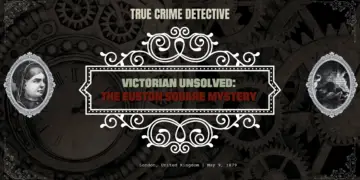
Review: The Lady in the Cellar: Murder, Scandal and Insanity in Victorian Bloomsbury by Sinclair McKay
The Lady in the Cellar: Murder, Scandal and Insanity in Victorian Bloomsbury DEALS
Sinclair McKay’s The Lady in the Cellar is an extraordinary foray into one of Victorian London’s most peculiar and haunting murder mysteries. The discovery of Matilda Hacker’s decomposing body in the coal cellar of a boarding house at 4 Euston Square in 1879 sets the stage for a gripping exploration of crime, scandal, and the complexities of Victorian society. While the identity of the murderer remains a mystery, McKay transforms this historical conundrum into a vibrant narrative that transcends the genre of true crime. The result is a deeply atmospheric and meticulously researched account that offers not just a window into the dark recesses of Victorian life, but also a thought-provoking reflection on human nature, societal norms, and the enduring allure of scandal.
McKay’s writing is steeped in rich historical detail, yet his storytelling is as gripping as any fictional whodunnit. The author’s ability to weave court transcripts, newspaper articles, and personal testimonies into a coherent and compelling narrative is remarkable. What emerges is not just a story of a crime, but a tapestry of Victorian London itself—its cultural obsessions, its fragile respectability, and its deep-seated hypocrisies. For readers interested in the Victorian era, this book is an immersive journey into the period’s social fabric, where morality was often performative, and the veneer of respectability could hide the darkest secrets.
A Window Into Victorian Society
Through McKay’s lens, 19th-century London becomes more than just a backdrop; it is a living, breathing entity. The city’s boarding houses—like the one at the heart of this story—represent a fascinating microcosm of the era’s social dynamics. McKay vividly illustrates how these houses served as spaces where different classes and cultures intersected. At Number 4 Euston Square, the Bastendorff family, immigrants from Luxembourg striving to establish themselves as respectable members of society, manage a household that operates as both a business and a home. Their world is further complicated by the lodgers they take in—each with their own secrets—and the domestic servants who navigate a precarious position within the household hierarchy.
McKay delves into the often-overlooked lives of Victorian servants, highlighting their essential role in maintaining households while exposing their vulnerability to exploitation and suspicion. Hannah Dobbs, the housemaid and one of the key figures in the story, exemplifies this precarious existence. Accused of theft and later implicated in the murder, Dobbs becomes both a suspect and a sensational figure in the tabloid press. Her subsequent decision to publish a pamphlet detailing her version of events provides an intriguing glimpse into the era’s growing appetite for scandal and sensationalism. McKay’s exploration of these dynamics underscores the blurred lines between respectability and ruin, making the book as much a study of Victorian social structures as it is a murder mystery.
A Complex Cast of Characters
The strength of McKay’s narrative lies in his ability to bring the individuals involved in this case vividly to life. Severin Bastendorff, the landlord of the boarding house, emerges as a complex figure—ambitious, enigmatic, and ultimately tragic. His immigrant background and success as a cabinet maker place him in a liminal position within Victorian society, striving for acceptance yet always under suspicion. His mental deterioration following the scandal is both heartbreaking and telling, reflecting the immense pressures placed on those who sought to climb the social ladder in an unforgiving era.
Equally compelling is Hannah Dobbs, whose role in the case remains tantalisingly ambiguous. McKay speculates on her motives and mental state, suggesting that her composed demeanour might align with what modern readers might recognize as sociopathy. Yet Dobbs is not portrayed as a straightforward villain; her resourcefulness and ability to manipulate the media hint at a woman shaped by her circumstances and the limited opportunities available to her. McKay’s nuanced portrayal invites readers to consider how societal pressures and personal ambition can intersect in unexpected—and sometimes destructive—ways. The supporting cast, from Matilda Hacker herself to the myriad lodgers and neighbours, adds further depth to the story, each offering a piece of the puzzle while reflecting the complexities of Victorian life.
True Crime and Its Limitations
At the heart of The Lady in the Cellar is the unsolved mystery of Matilda Hacker’s death—a mystery that continues to baffle historians and crime enthusiasts alike. Indeed, True Crime Detective covered the case before the book was published and having such a comprehensive resource would have been invaluable as McKay meticulously reconstructs the investigation, highlighting the limitations of Victorian policing. The rudimentary forensic techniques, combined with a heavy reliance on circumstantial evidence and public opinion, create an environment where justice seems more a matter of luck than skill. The spectacle of Hacker’s decayed body being displayed to the public for identification—a macabre practice unthinkable today—exemplifies the era’s often grotesque approach to solving crimes.
However, the unresolved nature of the case inevitably leaves readers with unanswered questions. While McKay offers theories and insights, he ultimately respects the unknowable aspects of the story. This adherence to historical accuracy is commendable, but it may frustrate readers who are accustomed to modern true crime narratives that tie up loose ends. Nevertheless, the ambiguity adds a layer of realism to the book, reminding readers that history, like life, is often messy and unresolved.
A Mixed Pacing
The book’s pacing will be divisive. McKay excels at immersing readers in the world of 1879 London, with his detailed descriptions of boarding houses, social customs, and the mechanics of the Victorian justice system. Yet this thoroughness occasionally veers into over-explanation. Lengthy passages on the operation of boarding houses or repetitive details about the case can slow the narrative, making some sections feel like a slog. A more streamlined approach might have kept the momentum flowing without sacrificing the richness of the context.
Despite these occasional lulls, the book’s more dynamic sections more than compensate. When McKay focuses on the characters or the courtroom drama, the story becomes utterly absorbing. The tension surrounding the trial and the media frenzy it sparked is palpable, drawing readers into the high-stakes world of Victorian justice. For those willing to persevere through the slower moments, the book offers a rewarding and thought-provoking experience.
A Broader Lens on History
What elevates The Lady in the Cellar beyond a straightforward true crime account is its exploration of broader historical themes. McKay situates the case within the wider context of Victorian society, examining everything from the rise of the tabloid press to the nascent field of psychiatry. The parallels he draws between the sensationalism of Victorian “penny dreadfuls” and modern media coverage are particularly striking, inviting readers to reflect on how little has changed in our consumption of scandal and tragedy.
The book also sheds light on the shifting dynamics of immigration, class, and social mobility in late 19th-century London. The Bastendorffs’ story, in particular, highlights the challenges faced by immigrant families striving to achieve respectability in a society that often viewed them with suspicion. McKay’s thoughtful analysis of these themes adds depth to the narrative, making it as much a social history as a crime story.
Summing Up
The Lady in the Cellar is an engrossing and meticulously crafted account that will appeal to fans of true crime, Victorian history, and social commentary. Sinclair McKay’s ability to weave historical detail with compelling storytelling ensures that this book is more than just a recounting of a crime—it is a vivid portrait of an era and its people. While the lack of a definitive resolution may leave some readers unsatisfied, it also underscores the complexities and ambiguities of real-life mysteries.
For those interested in the shadowy corners of history, McKay offers a fascinating glimpse into a world where respectability often masked scandal, and where the search for truth was as murky as the coal-stained cellars of Bloomsbury. Whether you are a seasoned true crime enthusiast or a newcomer to the genre, The Lady in the Cellar is a book that deserves a place on your shelf. Its combination of meticulous research, evocative prose, and thought-provoking insights ensures that it lingers in the mind long after the final page is turned.
The Review
The Lady in the Cellar: Murder, Scandal and Insanity in Victorian Bloomsbury
The Lady in the Cellar is a masterfully written and deeply engaging account, blending true crime with social history. Its slower moments and unresolved mystery hold it back slightly, but for fans of Victorian London or historical crime, it is a standout book worth reading.
PROS
- Rich Historical Detail
- Compelling Characters
- Social Commentary
- Well-Researched
- Evocative Writing
CONS
- Pacing Issues
- Lack of Resolution
- Occasional Over-Analysis
- Structure Limitations

























 Amazon
Amazon























